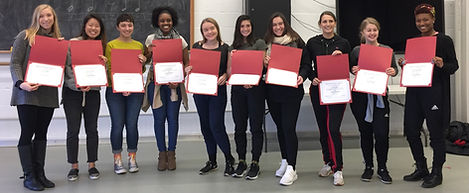Domain 4:
Professional Responsibilities
4a: Reflecting on Teaching
Reflection on instruction and student performance supports student success in the classroom as I adjust my teaching to accommodate, challenge, and uplift each student individually. Below, I've include my Instruction Commentary from my edTPA Intersectionality and Duet Choreography unit. Throughout the document, I reflect on both my teaching successes and missed opportunities as well as how I can address missed opportunities and continue to support student success in future classes.
Additionally, I've included an essay detailing an educational artifact, or an object, character, or concept that was formative in my educational upbringing. As important as it is to reflect on and analyze student performance and success in teaching, it is equally critical to acknowledge how one's background influences their teaching and engagement with students of all backgrounds. My essay examines the influence of Nancy Drew, a teenage detective who has been solving mysteries since 1930 when her character emerged. This reflection through the lens of education aided me in further understanding representation and the need for role models for students of all backgrounds and cultures to identify with. I am able to further understand my positionality in the classroom as a white female educator that may not be accessible to every student. Through this reflection I can prioritize social justice and equity as tools to develop and implement teaching practices that support students as unique learners.

4b: Maintaining Accurate Records
In order to track class performance during assessments, I implement tables, such as the one below. By documenting the classes overall performances, I can adjust my instruction in the following lessons to address student needs and to support student growth.

4c: Communicating with Families
Communication with families supports classroom learning and strengthens the classroom and school community. During my time at my first clinical teaching experience in Elizabeth, New Jersey, I aided my cooperating teacher in circulating flyers for a school fundraiser. The fundraiser flyer was printed on both sides of a sheet of paper, providing an English and Spanish version for students and their families. Equitable communication with families supports the involvement of more families and the potential inclusion of more voices, ideas, and cultures in the dance classroom.


4d: Participating in a Professional Community
Through my experience and engagement with online learning, I've co-presented alongside Rutgers students and faculty to engage with effective practices for online teaching. In May 2021, I will be co-presenting through Dance New Jersey with my EdM cohort on the effective blending of social justice standards and Non-Eurocentric dance forms such as Hula, Chinese Ribbon Dance, Hip Hop, Salsa, and Flamenco.


4e: Growing and Developing Professionally
Continued and invested work to enhance my knowledge of content and pedagogical skills is paramount to my growth as an educator. Below, I've include my certificate of involvement in the International Creative Dance Seminar in Beijing, China. During this week long conference, I was able to engage with dancers and educators from several US colleges and universities as well as from China, Korea, Taiwan, Australia, and France. On the left, I am photographed at my induction into the National Dance Honor Society as sponsored by the National Dance Education Organization (NDEO).




4f: Showing Professionalism
Professionalism in teaching is described as ethical conduct and service to students. I want to prioritize service and equitable treatment to all students in my classroom. Through the Guide for Racial Justice & Abolitionist Social and Emotional Learning, I can work to adapt my teaching practice to support varied student needs and address my own background and educational biases.